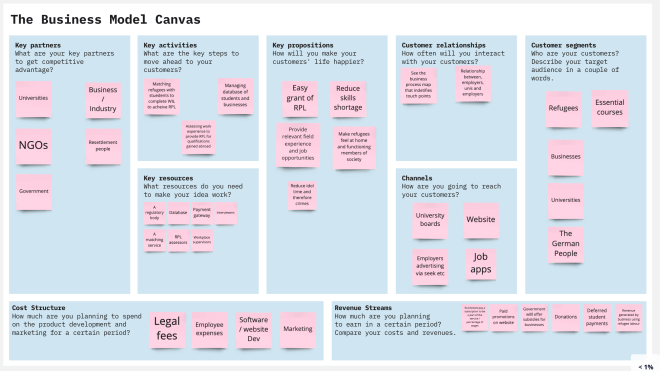The introductory slide for this sessions talked about refining our business models and testing some of the assumptions we had made.
Again iterative testing a prototyping really struck a chord with me in Agile software delivery we move from sketches to working beta versions of software (a minimum viable product) that our customers could start using straight away and then refine it based on the feedback, so when one of the slides Adapted from: An Introduction to Design Thinking Process Guide Institute of Design at Stanford (2010) said “Ideally test within a real context of the user’s life.” I was like “yesss!” realising that we really couldn’t do that because well we didn’t have the time, or access to our stakeholders (refugees) I was like “nooo 🙁 ”
However luckily Emma has some great suggestions for how to conduct some ‘desktop tests’ of our ideas. One that I had used previously in establishing both tie InterAct and Fidens Arbor was the business model canvas. If you are unfamiliar with it check out this two minute video.
Apply the business model canvass to our idea whereby we would seek to have refugees gain recognition for prior learning (RPL) through paid industry-based placement helped us do two things. The first was to consider all the bits and bobs, nuts and bolts we would need to create to make this service really work for our stakeholders as well as to make it a pleasure to use. Through this we identified that a service to match employers with refugee students was going to be crucial so that each could get the most benefit from the placement, and our minds went to a really fun and easy to use mobile phone (or computer browser based) application with some really cool data capture features, LinkedIn integration and smart backend algorithms to ensure that the right students found the right company to intern with, and vice-versa. The second thing it allowed us to do was to explore how we could make this service financially sustainable, and we looked at (based on an assumption that there was a skills shortage and that employers genuinely needed the skills the refugees had) the idea of companies paying a subscription to use the service, or paying the ‘service’ a percentage of their wages, we also considered revenue from advertising. This part of the model became crucial and when our unit chair Prof Alex Newman who has been looking at this wicked problem of getting more refugees into higher education for sometime now gave us (and all the other groups feedback) he really wanted people to consider the financial feasibility and sustainability of our solutions even more than we had, time permitting I am sure our initial thoughts could have been tested and our model further refined to find a winning combination.

Based on the identification of the matching service as possibly the most lucrative and humanly pleasing to use in the form of an app we refined our prototype even further. We refined our storyboard to focus on just the matching service

And mocked up some screens for the app supporting the matching service. You can see some other cool features here including links to aptitude tests which make matching the right student with the right employer even easier.

At this point we just had to get it all together into some kind of final presentation to present to the whole class and the academic staff tomorrow …… we were all a little nervous. To be continued for the gripping conclusion.